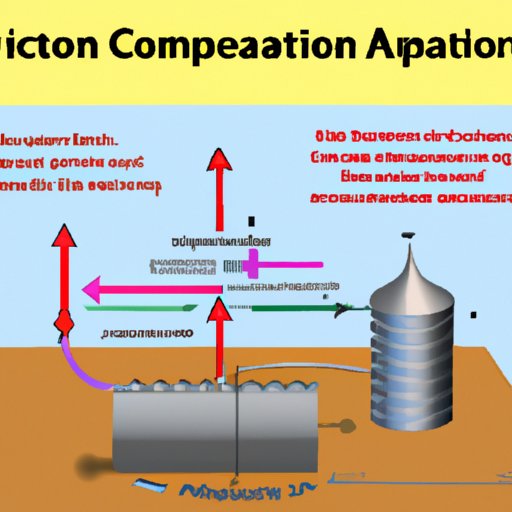Introduction
Air compression is the process of compressing air into a smaller space. This process is used to increase the pressure of the air, which can then be used for a variety of applications, from powering tools and machines to providing pressurized air for medical treatments. In this article, we will explore the basics of air compression, its uses, and the physics behind it.

Explaining the Basics of Air Compression and Its Uses
What is Air Compression? Air compression is the process of compressing air in order to increase its pressure. The compressed air is then used for a variety of applications, from powering tools and machines to providing pressurized air for medical treatments.
Types of Air Compressors. There are several types of air compressors, including rotary screw compressors, reciprocating compressors, centrifugal compressors, and turbo compressors. Each type of compressor has its own advantages and disadvantages, so it is important to select the right type for your specific application.
How Does Air Compression Work? Air compression works by using mechanical energy to reduce the volume of an enclosed space. This reduces the amount of air inside the space, which increases the pressure. As the air is compressed, the kinetic energy of the molecules inside the space increases, resulting in higher pressure.
A Step-By-Step Guide to Understanding Air Compression
Step 1: Determine Your Compressor Needs. Before selecting an air compressor, you need to determine your specific needs. This includes determining the required pressure, flow rate, and power requirements for your application.
Step 2: Select the Appropriate Compressor. After determining your needs, you can then select the appropriate compressor for your application. Be sure to consider factors such as size, weight, portability, and noise level when making your selection.
Step 3: Install the Compressor. Once you have selected the appropriate compressor, you can then install it according to the manufacturer’s instructions.
Step 4: Maintain and Monitor the Compressor. After installation, it is important to maintain and monitor the compressor on a regular basis. This includes performing routine maintenance, such as changing the oil, cleaning the filter, and checking the pressure gauge.

Examining the Physics Behind Air Compression
Pressure and Volume. One of the most important concepts to understand when it comes to air compression is the relationship between pressure and volume. According to Boyle’s law, the pressure of a gas is inversely proportional to its volume. This means that as the volume decreases, the pressure of the gas increases.
Entropy. Entropy is another concept that is important to understand when it comes to air compression. According to the second law of thermodynamics, entropy always increases in a closed system. This means that as the air is compressed, the entropy of the system increases.
Isothermal Processes. Isothermal processes are also important when it comes to air compression. An isothermal process is one in which the temperature remains constant. This means that as the air is compressed, the temperature of the air remains the same.
Investigating the Benefits of Utilizing Air Compression
Cost Savings. Air compression can provide significant cost savings due to its ability to reduce energy consumption. By reducing the amount of energy needed to operate machinery and equipment, companies can save money on their energy bills.
Increased Efficiency. Air compression can also increase efficiency by reducing the amount of time it takes to complete tasks. By decreasing the amount of time it takes to complete tasks, companies can increase their productivity and improve their bottom line.
Improved Safety. Air compression can also improve safety by reducing the risk of accidents and injuries. By using compressed air instead of manual labor, companies can reduce the risk of accidents and injuries caused by overexertion or fatigue.
Conclusion
Air compression is an important process that is used in many industries today. It can provide cost savings, increased efficiency, and improved safety. Understanding the basics of air compression and its uses can help you make the most of this process and get the most out of your applications.
(Note: Is this article not meeting your expectations? Do you have knowledge or insights to share? Unlock new opportunities and expand your reach by joining our authors team. Click Registration to join us and share your expertise with our readers.)
